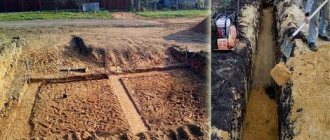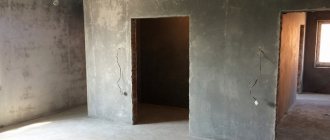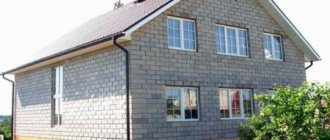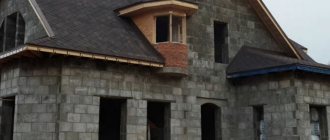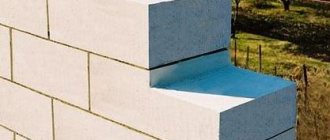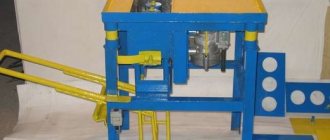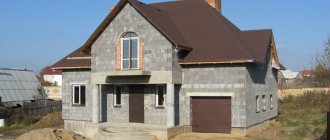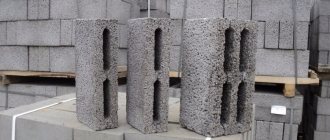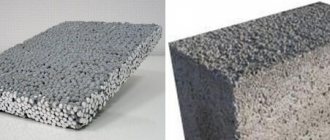Home |Cement |Warm mortar for ceramic blocks
Date: January 5, 2019
Comments: 0
The use of ceramic blocks, characterized by a porous structure, is common in the construction of various objects. The products are in demand in the construction of private buildings, as they are durable, have high performance characteristics, and retain the heat of the room well.
For laying ceramic blocks, it is advisable to use special solutions to prevent the formation of cold bridges. To ensure reliability, quality and comfortable operation of the building under construction, masonry mortars must have a low thermal conductivity coefficient. This is achieved by introducing special fillers characterized by low density.
Warm masonry mortar significantly reduces heat loss, reduces the weight of the structure being built, and reduces the need for binding materials used for laying blocks. Let us dwell in detail on the types, characteristics, advantages, preparation features, and consumption of compositions for laying blocks of porous composites.
Thermal insulating masonry mortar LM is specially designed for porous bricks and blocks, which significantly reduces heat loss through mortar joints
CHARACTERISTICS AND MAIN PROPERTIES
It has long been known from school physics courses that air is a poor conductor of heat. Based on this, a logical conclusion suggests itself: in order for a building structure made of porous materials to retain heat well, the solution must contain “air-absorbing” substances. Most often, such fillers are perlite or expanded clay sand.
If the density of the binder “dough” exceeds the density of the wall material for every 100 kg/m3, then the heat loss of such a structure increases by 1%.
External wall structures are often made of lightweight materials with a high coefficient of thermal resistance. In this case, a mixture of lower density than traditional cement-sand mixture is required as a binding material.
The latter has a high density (up to 1800 kg/m3), resulting in additional heat loss due to “cold bridges”. If the density of the binder “dough” exceeds the density of the wall material for every 100 kg/m3, then the heat loss of such a structure increases by 1%.
In order for this physical characteristic of the binder mixture and the wall material to be comparable, it is necessary to prepare a special “warm” solution, the density of which would be 500-800 kg/m 3. This composition must have high ductility, crack resistance, good adhesion, moisture-holding abilities, and sufficient viability.
The strength of a building structure largely depends on the wall material, and not on the brand of the composition. The brand of the latter, as a rule, must coincide with the technical characteristics of the brick. However, when using a mixture of one grade lower, the reduction in masonry strength drops by only 10-15%.
Minimum grades of mortars (from M10 to M50) are used for buildings of the 1st degree of durability, as well as for masonry of low-rise buildings made of highly porous materials, the strength of which is 3.5-5 MPa. Thus, for this type of building, binder mixtures with a strength of 1 to 5 MPa should be used.
ADDITIONAL DENSITY REDUCTION
The average density of the binder composition, as mentioned above, is reduced by the use of low-density fillers. However, a reduction in the density of the mixture can be achieved with the presence of a traditional filler - sand.
When using turbulent mixers and air-entraining additives, the density of the sand solution can be reduced from 1600 to 900 kg/m 3, which corresponds to a strength of 0.3-4.9 MPa. This mixture corresponds to brands M4, M10, M25.
Traditional fillers for warm mortar should have a density of 800 to 500 kg/m3 and have a strength of up to 10 MPa. air-entraining additives
One of the ways to reduce the density of building mixtures is to prepare the solution using special mixing equipment - a steam generator. A good effect can be achieved by porous cement stone using turbulent mixers. This technology is applicable only with the use of air-entraining additives.
The most effective method of preparing a warm solution is the simultaneous use of porous aggregates and air-entraining additives.
The choice of the type of porous aggregate depends on the composition of the raw material base, operating conditions, and the average density of the wall material. Traditional aggregates must have a density of 800 to 500 kg/m3 and have a strength of up to 10 MPa.
HOW TO PREPARATE A WARM SOLUTION?
Warm masonry mortar is more often used for the construction of external walls; for internal walls, a traditional cement-sand mixture is used . This composition can be prepared with your own hands or using a concrete mixer at low speed. To prepare this “construction dough” you can use ready-made mixtures, to which you just need to add water and mix.
If you plan to prepare the binder composition yourself, then all the components are mixed dry, and then water is added.
The “warm” mixture is prepared in the following proportions: 1 part cement and 5 parts filler (expanded clay or perlite sand). The dry mixture is mixed, and then 1 part water to 4 parts dry mixture is added. The mixed solution should stand for 5 minutes, then it can be used for its intended purpose.
Proportions for preparing a warm solution: 1 part cement + 5 parts filler (expanded clay or perlite sand), 1 part water to 4 parts dry mixture
The prepared “dough” should have a medium-thick consistency. Excessively liquid composition will fall into the voids of the blocks, thereby interfering with thermal insulation.
Construction work is best done in the warm season. The reason for such seasonal preferences is not only favorable weather conditions for working outside, but also the fact that at low temperatures the masonry mortar hardens very quickly. However, if you still have to work at air temperatures below 5°C, then special additives are added to the solution.
But even such “anti-frost” impurities do not save the masonry from reducing its strength.
The heat-saving mixture ensures that the walls are laid more uniformly, despite the fact that the amount of mortar in it is only 4% of the entire area! Warm masonry mortar allows for maximum heat retention, reduces the weight of wall structures, and also reduces the consumption of building materials.
Comparison with sand-cement mortar
The cement-sand composition used for masonry is a cold one, in which sand is used, which differs in thermal conductivity properties from expanded clay chips and perlite filler used in warm compositions.
Warm mortar for building walls using ceramic blocks is significantly different from traditional cement mortar with the addition of sand. Main distinctive points:
- Consumption during laying. Warm masonry mortar has a plastic consistency that provides a high degree of contact with the ceramic block, the cavities of which cover more than half of the surface of the product. This contributes to a significant reduction in the consumption of the mixture (up to 1.8 times compared to cement-sand) used in the construction of walls. The cement-sand mixture does not have the required plasticity. It is intensively absorbed into the surface of the ceramic composite and is consumed in an increased volume, which is associated with a significant portion getting into the cavities present on the surface of the blocks.
- Convenience of work. The use of industrially produced masonry compounds allows the construction of walls without wetting the surface of the composites. This is due to the ability of the composition to retain water for a long time. The use of a conventional mixture requires preliminary moistening of the ceramic products in order to ensure good adhesion.
- Economical. Warm mortar has a reduced volumetric weight compared to standard sand-cement. This is due to the use of lightweight aggregates instead of sand, which significantly reduce the mass of the masonry. The result is a reduction in the load on the foundation, on the construction of which you can seriously save money.
Warm masonry mortars are prepared using cement and lightweight aggregates - expanded clay or perlite sand, polystyrene foam granules
Significantly superior to cement-sand mortar in most characteristics, warm masonry mortar occupies a leading position among building mixtures used for the construction of walls made of ceramic blocks.
Warm masonry mortars: how to get rid of cold bridges
The seam between the bricks is the most vulnerable point in the facade of the house. Its thermal conductivity is significantly higher than that of ceramics. Meanwhile, the area of the seams of external walls can reach 10-12%. Today it is quite easy to solve this problem, which is in one way or another connected with unfavorable winter conditions, but now during the operation of the building. Manufacturers of dry construction mixtures offer warm masonry mortars that have a special composition.
The main component of any cement-based mortar is sand. Accordingly, by changing its properties, you can count on improved thermal conductivity. That is why not ordinary sand is added to the warm solution as a filler, but vermiculite or expanded perlite. This significantly reduces the overall density and achieves lower thermal conductivity values that are not inferior to ceramics. As a result, warm masonry mortars guarantee the absence of cold bridges. This is very important for creating a comfortable indoor microclimate.
Is it possible to create it yourself?
The production of building materials requires adherence to technology and the ratio of the components included in the composition. For personal needs in limited quantities, concrete can be made independently. Violation of proportions and technology will lead to low quality. The problem with such mixtures is foreign debris.
It is recommended to take into account that the cost of producing the mixture will be higher than when purchasing from specialized enterprises. Additional transportation costs will result from purchasing materials from different suppliers.
Warm masonry mortars for ceramic blocks
The popularity of ceramic blocks is explained by their excellent thermal conductivity characteristics and a wide range of standard sizes. One block can replace 16 bricks in a wall; therefore, masonry work takes several times less time than when working with traditional materials. The thermal conductivity of porous blocks is 4-5 times lower than that of brick, which is why they are called warm ceramics. Accordingly, it is better to use special mixtures to work with it. A warm solution for ceramic blocks will reduce heat loss to a minimum. The wall actually becomes homogeneous, making the building being built energy efficient.
One of the leaders in the market of modern building materials is the Wienerberger company. Its factories are located in many European countries, and its products are in high demand. The concern produces Porotherm warm solution for its ceramic blocks. Its use will allow you to feel all the benefits of warm ceramics. The coefficient of a masonry joint made of Porotherm is only 0.19 W/mS. Its preparation is not difficult, the only thing is that the manufacturer recommends that you always prepare a warm solution for masonry using clean water.
Advantages
Warm mixtures for laying ceramic composites are produced using advanced technologies and are popular among builders of various levels. They have many serious advantages, the main of which are:
- high quality of products produced using industrial technology with strict adherence to the requirements of the quality system in force at the manufacturer;
- increased thermal insulation characteristics, ensuring a comfortable thermal condition of the room by reducing heat loss occurring through cold bridges;
- plastic consistency of the composition, which helps retain moisture and reduces the need for the composition when doing masonry;
During masonry work, it is necessary to provide protection for masonry joints from too rapid drying and atmospheric influences - sun, rain, frost
- low specific gravity, due to which the total mass of the structure being erected and the forces acting on the base of the building are reduced;
- high level of sound absorption, creating a favorable acoustic environment in the room and making it difficult for extraneous noise to penetrate;
- fire-retardant characteristics that allow them to withstand elevated temperatures for a long time while maintaining strength;
- affordable price, allowing developers with average financial capabilities to use mixtures for laying ceramic composites;
- high decorative characteristics, providing a presentation after hardening and the possibility of use in interior decoration.
The use of warm mortars for laying blocks is a guarantee of the strength of the walls being erected, the reliability of buildings and a comfortable thermal regime in the room.
Cost of warm masonry mortars
The excellent performance characteristics of materials are often the reason for increased interest in its cost. Indeed, the price for warm mortar is almost twice as high as for ordinary masonry mortar. However, its use reduces heat loss by 10-15%, which with simple calculations will make it easy to understand that the use of this material is beneficial to developers. When choosing warm solutions, it is best to give preference to products from well-known manufacturers. Despite the higher price, they have a 30-40% higher yield of the finished solution, which allows you to save significant money.
Warm mortar, warm mortar for laying ceramic blocks
Although ceramic blocks appeared in the field of private housing construction relatively recently, they have already gained the status of a promising and high-tech material. The hollowness of the structure ensures a low level of thermal conductivity, which gave rise to the blocks being given the second name “warm ceramics”. Like all materials for building walls, ceramic blocks require installation, which is done quite traditionally - using masonry. But it is advisable to use a special, warm mixture for masonry.
Content:
Warm mortar for ceramic blocks - basic properties
Since ceramic blocks are a heat-saving material, to obtain masonry with low thermal conductivity it will be necessary to use special mixtures, a mandatory addition to which can be lightweight porous substitutes, such as:
- vermiculite,
- pumice,
- perlite, which are quite effective heat insulators.
For laying ceramic blocks, a warm solution is used, the composition of which is as follows:
- Portland cement - as a binding component,
- additives of polymer origin - to improve the plasticity of the finished mixture, accelerate its hardening, increase frost resistance, water resistance,
- porous fillers.
The area of use of warm masonry mortars is quite extensive, except for laying ceramic hollow blocks it is used in the construction of houses from aerated concrete blocks and large-format blocks from cellular concrete. The properties of the warm solution allow it to emphasize all the advantages of these wall materials.
advantages
High-quality masonry completely eliminates the possibility of cold bridges, increasing the resistance to the heat transfer process by approximately 30%. In addition, lightweight fillers make it possible to minimize the pressure exerted by the walls on the foundation. Considerable savings can be achieved by reducing the consumption of masonry material.
Due to the high moisture-holding abilities of the warm mortar, it is possible to use it in masonry using thin-seam technology. Filling the joints in the masonry with a solution that has low thermal conductivity can significantly reduce the volume of heat flows penetrating through the masonry and reduce their speed.
At the same time, a warm solution is permeable to vapors, i.e. allows you to maintain optimal humidity characteristics in your home; condensation will not settle on the walls in such a room. Thanks to the use of warm masonry mixtures, home owners will not be in danger of the appearance of fungal and mold cultures on the walls.
Naturally, the owners of the premises will receive savings on the maintenance of the house itself and its heating in the winter.
The consumption of warm mortar for ceramic blocks will be approximately 1.75 times less than conventional sand-cement mortar, due to the low density of the former.
Watch a video about the properties of perlite solution, its preparation and use:
Features of preparing warm masonry mortar
In most cases, warm mortar is used when laying external walls; for internal walls, a regular sand-cement analogue is more often used. Prepare a warm solution with your own hands or using a concrete mixer; if the volume is expected to be large, then it is best to rent a concrete mixer - the speed of work will increase significantly. You can prepare construction dough from packaged ready-made mixtures - you just need to add water to them and then mix thoroughly. A standard bag weighing 35 kg will yield about 31 liters of finished solution.
If the components are purchased separately, then you will first need to mix all the ingredients in dry form, only then can you add liquid.
When preparing a warm solution, it is recommended to observe the following proportions:
- per 1 piece of cement binder, add perlite or expanded clay sand - 5 parts,
- For 4 parts of the mixture in dry form, you will need to use 1 part of water.
Water should be used from a tap; mineral impurities in water from reservoirs can affect the balance of the components of the prepared solution.
The consistency of the finished solution should be medium-thick - very liquid will fill the voids of the blocks and reduce their thermal insulation characteristics. Before use, the solution should be allowed to stand for 5 minutes.
If you make a warm solution thick, it will lose its ability to provide reliable fastening - ceramic blocks absorb too much moisture - the solution will dry out before it has time to gain strength. An excessively liquid solution will lead to an increase in material consumption - losses will increase due to the presence of voids in the blocks. The use of ready-made mixtures will avoid the need to moisten the blocks - a warm solution is able to retain moisture for a sufficiently long period.
The best time for construction is the warm season; low temperatures cause the mortar to set too quickly, which ultimately does not improve the quality of the masonry. When masonry is carried out at temperatures below +5 C, anti-frost additives should be added to the solution, but they will not save the masonry from reducing its strength either.
Since perlite is the most popular of the binding thermal insulation materials, when preparing the solution it is customary to replace sand with it. Experts warn that such a composition should not be mixed in a concrete mixer for too long - perlite has a tendency to granulate and form into dense lumps. Having obtained a homogeneous mass, the mixing process should be stopped.
When laying a private house, you can add color to the mortar; this will increase the decorativeness of the masonry; the color does not have a negative impact on the quality.
Watch the video on how to properly prepare masonry mortar:
Criteria for choosing a composition for preparing plaster
In specialized construction stores today you can find dry, warm masonry mixtures from different manufacturers, which differ in their markings. This is very convenient for buyers - they can choose exactly the one that is suitable for a specific building material and contains the desired percentage composition:
- thickener,
- plasticizer,
- modifiers.
10 kg of dry mixture can contain from 150 to 200 g of various additives. Ultimately, the quality of the solution, its strength and adhesion are determined by the balance of the amount of modifiers.
Of course, using a warm solution for ceramic blocks, the price of which is significantly higher than the cost of ordinary sand-cement, may be considered wasteful by some. However, experts advise not to compromise and not to look for mixtures exclusively among cheap analogues - ideal product quality can usually only be guaranteed by manufacturers of warm ceramic blocks. There is no point in spending money without confidence that the product will allow you to obtain sufficiently high characteristics of the masonry mortar.
If we are talking about getting savings by using a regular sand-cement mixture, then you will need to make it thicker in consistency, and soak the ceramic blocks in water before laying. Only this option will make it possible to obtain strong and reliable masonry. In this case, the consumption will decrease slightly, and the amount of moisture absorbed by the ceramic block will also become less. To simplify the laying process, it is recommended to add plasticizers to the mixture.
Experts advise: the thickness of a masonry joint made from ordinary mortar should not exceed 1-1.2 cm, otherwise cold bridges will form, and therefore there will be heat loss.
Watch a video about how to build a warm house:
Of course, it is up to the home owner to decide whether to use warm mortar or regular mortar when building a house. But does it make sense to save about 10% on the cost of the walls, and then spend extra money on heating the house throughout the entire period of operation.
Consumption of mortar for laying blocks
For laying 1 m 2 single-layer wall
from smooth blocks 30 - 40 cm thick. Approximately
20 - 30 liters of mortar are needed
with a joint thickness of 10-12 mm.
For buildings with a height of 1-2 floors, it is possible to further reduce heat loss through the mortar joint, as well as reduce its consumption.
To do this, when laying the mortar, apply it in two stripes along the outer and inner surfaces of the wall, leaving in the middle of the wall an air gap in the seam 1/3 - 1/4 wide of the width of the block. This measure reduces the thermal conductivity of the seam, but at the same time reduces the load-bearing capacity of the masonry - therefore it is used only for buildings of small height.
A smaller amount of mortar will be needed if you use blocks with a tongue-and-groove connection of vertical joints for masonry. In this case, vertical seams are not filled with mortar.
The use of warm, lightweight masonry mortar can significantly improve the thermal conductivity of the wall compared to conventional mortar, but not so much as to be on par with an adhesive joint. In addition, the consumption of glue is several times less than that of a light solution, and the price of ready-made dry mixtures of glue and solution is almost the same.
Warm light masonry mortar is not recommended for laying walls that can be intensively moistened - foundation, basement, basement.
For information on laying gas silicate and aerated concrete blocks with glue, read the article Laying gas silicate and aerated concrete blocks with glue.
Interior finishing of aerated concrete walls
Laying walls from aerated concrete blocks - video tutorial
More articles on this topic
Dear reader!
Warm lightweight masonry mortar for laying block walls: 2 comments
There is nothing here about vermiculite, but it will give a head start to both foam plastic and mineral wool. Especially when insulating flat roofs, attics, basements, walls, including frame house construction. It can also be used in the production of warm plasters and masonry mortars with low thermal conductivity. More detailed information about vermiculite can be found here ZTVERM.RU technical. characteristics, comparison with other materials, recipes.
“When constructing the walls of buildings made of cellular concrete, there is a problem of different thermal conductivity of the walls themselves and the adhesive mortar. Significant losses of thermal energy occur through masonry seams (up to 10% when using thin-layer adhesives, up to 30% when using cement-sand mortars), which leads to increased heating costs.” One of the solutions to improve the thermal insulation properties of masonry made from aerated concrete blocks is the use of adhesive for cellular concrete thermal insulating brand Gemisch. The main difference between the adhesive for cellular concrete heat-insulating brand Gemisch and traditionally used adhesives is its high thermal efficiency, the thermal conductivity coefficient of Gemisch adhesive is only 0.202 W/(m*K), which practically corresponds to the thermal conductivity of the blocks themselves, i.e., as a result of using Gemisch adhesive we we get an almost monolithic wall, and the absence of “cold bridges”. Along with excellent thermal insulation characteristics, Gemisch adhesive has a number of advantages compared to traditionally used adhesives: - Lightweight. The bulk density of Gemisch glue is only 1000 kg/m3, which is more than 30% less than the bulk density of traditional adhesives, as a result of which the costs of delivering Gemisch glue to construction sites are significantly reduced, and the masonry process is also simplified; - Economical. 1 bag of Gemisch glue 18 kg, replaces 25 kg of traditional glue, thanks to the finely dispersed composition of Gemisch glue, it has become possible to lay blocks with a seam thickness of only 1 mm. - Minimum consumption. Thanks to the finely dispersed composition of Gemisch adhesive, it became possible to lay blocks with a joint thickness of only 1 mm. - Durable. High adhesion to the base (at least 0.6 MPa) and strength grade M100 guarantee reliable adhesion of materials. - Universal. Gemisch adhesive is suitable for laying blocks made of cellular concrete, polystyrene concrete, as well as ceramic blocks and bricks.
The use of ceramic blocks, characterized by a porous structure, is common in the construction of various objects. The products are in demand in the construction of private buildings, as they are durable, have high performance characteristics, and retain the heat of the room well.
For laying ceramic blocks, it is advisable to use special solutions to prevent the formation of cold bridges. To ensure reliability, quality and comfortable operation of the building under construction, masonry mortars must have a low thermal conductivity coefficient. This is achieved by introducing special fillers characterized by low density.
Warm masonry mortar significantly reduces heat loss, reduces the weight of the structure being built, and reduces the need for binding materials used for laying blocks. Let us dwell in detail on the types, characteristics, advantages, preparation features, and consumption of compositions for laying blocks of porous composites.
Thermal insulating masonry mortar LM is specially designed for porous bricks and blocks, which significantly reduces heat loss through mortar joints
How to lay ceramic blocks
Construction technologies are constantly updated. New materials appear, replacing old ones. Thus, relatively recently, a large-format building material called warm ceramics or porous ceramic blocks appeared on the market. The blocks contain high-quality clay, sawdust and water. These components are environmentally friendly, which means that products made from them meet high environmental safety requirements. The blocks have a porous structure, which improves sound absorption and thermal insulation properties. These and other features of ceramic blocks have made them especially popular in the construction of single- and multi-story buildings in many European countries. This article will talk about how to lay ceramic blocks, but first, we suggest you familiarize yourself in more detail with the advantages of this material.
Where is it used?
Concrete is used in the construction of objects for various purposes. The material meets the established requirements of the State Standard.
The mixture is mainly used for the following purposes:
- construction of cottages;
- floor insulation;
- in the heating system;
- installation of roofs, structures, walls of previously erected structures;
- during the construction of multi-storey buildings.
Partitions and fences are created from block elements. After laying the material, all that remains is to plaster the surface and do the finishing. Concrete with polystyrene filler is not suitable for foundations or road surfaces.
Advantages and disadvantages
Warm ceramics are used by both professionals and amateur craftsmen. For the sake of objectivity, the pros and cons of the material will be given below. So let's start with the benefits. This list includes:
- Stability and strength. Modern block manufacturing technologies have made it possible to obtain a unique combination of low thermal conductivity and high strength grade of the material. Ceramic blocks retained the parameters of ordinary red brick and acquired new properties.
- Energy efficiency. Ceramic blocks provide high quality air-heat balance. This means that fresh air will flow into the room with minimal heating costs.
- Environmental safety and natural air conditioning function. Thanks to the capillary structure of the blocks, air penetrates through the pores of the walls, creating natural moisture exchange. Thus, the walls will play the role of a natural air conditioner: if there is excess moisture, it will be absorbed into the walls, and if the air in the room is too dry, the walls will make up for the lack of moisture. Thanks to this, the likelihood of the formation of fungi and mold on the surface of the walls is eliminated.
- Cracks will not appear on plastered walls, since ceramic blocks do not shrink.
- Tongue-groove joint. The tongue-and-groove joining technology makes it possible to lay blocks even in a vertical position.
- Plastering ceramic block walls is very simple, as they have a slightly rough corrugated surface, which ensures reliable adhesion of the plaster mixture to the wall surface. This is also very economical, since to plaster a wall made of ceramic block you will need one and a half times less plaster mixture than for a wall made of ordinary red brick.
- Ceramic blocks are more voluminous than ordinary bricks. Due to this, walls made of this material are erected several times faster than those made of brick. Thus, the cost of construction is reduced.
- The light weight of the blocks reduces the load on the foundation. Savings can be up to 40%.
- Ceramic blocks have high thermal insulation properties, so there is no need for additional insulation of structures built from them.
Each material has both advantages and disadvantages. Therefore, it is worth mentioning the disadvantages of the material. The main disadvantage is considered to be the low load-bearing capacity and strength of warm ceramics. Therefore, when building a house from ceramic blocks, it needs to be further strengthened. It will not be possible to screw racks, ladders and other heavy products to the walls.
What properties does it have?
Before using thermal concrete in construction, it is recommended to familiarize yourself with its main advantages.
The material is characterized by:
- ease of design;
- low thermal conductivity;
- increased strength;
- environmental cleanliness;
- fire safety;
- resistance to low temperatures and earthquakes;
- ease of installation;
- antibacterial properties;
- hydrophobicity.
In construction, the composition is used as a separate material and in the form of monolithic products, the installation of which facilitates quick installation.
Preparation of masonry mortar
Laying ceramic blocks cannot be done using the mortar used for laying ordinary red brick. In this case, special masonry thermal insulation solutions should be used. This is due to the difference in the thermal properties of these materials.
Note!
If you make seams from ordinary cement-sand or lime-cement mortar, they will create cold bridges. Consequently, the thermal insulation properties of the walls will be significantly reduced.
The binder of the so-called warm solution is cement, and expanded clay sand, perlite or pumice are used as fillers. It is worth noting that the use of warm masonry mortar is advisable when laying external walls. For the construction of internal walls, ordinary mortar is used. It is prepared manually or in a concrete mixer at low speed.
Ready-made mixtures are available for sale, sold in dry form. All that is required from the builder to prepare the solution is to add water according to the instructions included with the mixture. The solution should be medium dense. It should not fill the voids of the blocks.
Note!
Warm solution improves the thermal performance of masonry by 17%.
What is used for laying blocks?
When purchasing blocks made from ceramic composites, developers are wondering which masonry mortars are best to use? The following options are possible:
- use warm mortar produced in production conditions for the construction of block walls. It is made on the basis of expanded clay or perlite filler and is supplied in sealed packaging. It is characterized by the presence of modified components and special plasticizers that reduce consumption, are resistant to negative temperatures and affect plasticity;
- Prepare your own perlite-cement mixture using crushed perlite. Perlite is popular among developers who individually prepare the composition for laying ceramic blocks. It is mixed with cement in a ratio of 1:3 with the addition of a special plasticizer, which increases the plasticity of the building mixture. Mixing is carried out in a concrete mixer for a limited time, which is due to the ability of perlite to granulate and form dense lumps;
- use traditional sand-cement mortar, the only advantage of which, compared to the above options, is its low cost. Ensuring plasticity is achieved by introducing plasticizers for dry mixtures. But this does not solve the problem of heat loss due to the formation of cold bridges.
Let's look at how warm mixtures differ from those traditionally used based on cement and sand.
For laying external single-layer walls made of blocks, heat-insulating lightweight warm mortars should be used
Joints used for laying ceramic blocks
When laying ceramic blocks, a so-called bed seam is used. It is important to maintain a certain balance. A very thin seam will not equalize the horizontal errors of the blocks, and a thick one will worsen the strength of the masonry. The optimal seam thickness is 12 mm. The solution is applied evenly.
Note!
Load-bearing walls are subject to static load, so the masonry joint must be continuous. When building partitions, the masonry seam may be intermittent.
In the south of the country, external walls can be built from less thick blocks. When laying brick walls, you need to make not only horizontal, but also vertical joints. Ceramic blocks are connected to each other using tongue-and-groove technology, which eliminates the need to fill vertical joints with mortar. This not only helps save mortar, but also reduces construction time.
Features of masonry
Before laying begins, a waterproofing solution is laid on the base, on which a waterproof material should be laid. In this case, the width of this material should exceed the thickness of the masonry by 2–3 cm.
Note!
Reliable waterproofing between the base and the wall being built is a guarantee of the strength of the house.
After waterproofing the base, a bed or horizontal seam should be applied. It needs to be leveled. In this case, you should start at the highest point. Walls made of porous ceramic blocks are laid in warm, dry weather. The air temperature should be above +5℃. Unfinished walls should be covered with waterproof material at night and during rainfall.
Masonry starts from the corners. The first blocks are laid in the corners and connected to each other along the outside with a mooring cord. Subsequent blocks are inserted into one another along a cord. In this case, horizontal displacement of the masonry should not be allowed.
It happens that the block sizes are slightly different. In this case, they need to be cut down with a tabletop circular saw or a hand-held electric chain saw. When laying the first row, it is important to strictly observe the horizontal and angles. If there is a slight deviation from the horizontal, the blocks are tapped with a rubber hammer. The surface of each row is moistened with water before applying the solution and laying the next one. If mortar leaks onto the outside of the wall, it should be collected. This can be done with a spatula.
The dressing of masonry and walls deserves special attention. The integrity of the structure depends on this. The shift of blocks in adjacent rows must be at least 0.4 of the block height. The connection of the outer wall with the inner wall is carried out with perforated steel anchors. They are laid in horizontal seams in odd rows.
So, now you are ready to build walls from porous ceramic blocks. For clarity, we have placed video materials at the end of this article. If you still have questions, ask our expert. He will kindly provide you with additional information.
Preparation of warm masonry mortar
With the advent of new building materials, corresponding terms are formed, such as, for example, warm masonry mortar.
Previously, it was understood in the literal sense: the usual building mixture of cement and sand, but heated for work in cold conditions to ensure the quality of the brick wall. But now ceramic blocks with many pores have appeared, increasing the thermal insulation properties of the structure, and the previous composition becomes a weak link: the seams are a kind of cold bridges, that is, heat leaks through them. This circumstance led builders to create mixtures of specially selected components that provide high thermal insulation of joint fillers. Porous minerals and products became such elements of the solution:
- pumice, expanded clay and slag sands;
- expanded perlite and vermiculite;
- foam glass and asbestos-containing substances.
This made it possible to increase the heat resistance of the seams by 18%. Solutions on such bulk materials are used in the construction of structures made of foam concrete, porous ceramic blocks, cellular glass, glass foam and gas silicate concrete blocks.
Preparation for use
Regardless of the manufacturer of the heat-insulating masonry composition, before starting work, a preparatory stage should be carried out, including:
- Removing dust, grease stains and dirt from masonry blocks.
- Control of surface horizontality and assessment of strength properties.
- Preparation of the composition for laying ceramic blocks, according to the manufacturer’s recommendations.
General rules for preparing warm mixtures include mixing with water in the required proportions, settling and re-mixing. The consistency should be plastic and, at the same time, hard. The resulting composition should be protected from direct sunlight, temperature fluctuations, high humidity and dirt.
Properties and compositions
Air is a poor conductor of heat; it is this quality that has allowed cellular products to become the basis of heat-saving technologies. When erecting structures from macroporous building materials, it is necessary to lay wall elements in mortars with light aggregates - this is perlite or pumice sand. Traditional masonry mass has a density of 1.8 t/m³, while wall blocks are much lighter - 0.5 t/m³. A pattern has been revealed that with an increase in the specific gravity of a substance by 100 kg/m³, heat leakage increases by 1%.
The ideal solution would be to achieve a mass density at the level of the weight of building blocks - 0.5. Such a mixture must also be workable and plastic, have high adhesion (sticking to the surface) and moisture-retaining properties to ensure the viability of the solution. A combination of such parameters can be achieved by including special additives in the mortar mass - modifiers that improve the properties of the composition. Thus, the warm masonry mixture should consist of the following components:
- cement;
- porous sand powder;
- modifying additives.
Light fillers are selected based on the capabilities of the local mineral mining base. The cement-sand ratios are the same as for traditional mortars, depending on the required strength. These can be proportions 1:3 (M 75), 1:4 (M 50) and 1:5 (M 25). The last two dosages are used for low-rise construction of houses with walls made of highly porous blocks.
Achieving minimum density
An additional possibility of saturating the solution with air and thereby reducing its weight is the use of turbulent mixers when mixing the masonry composition. At the same stage, air-entraining additives also have a good effect. Pore generators have also been developed and operate, saturating the solution with air pores while mixing it.
In some cases, polystyrene foam granules can be used as filler, which have practically no weight and saturate the mass with air very well. For plasticity, lime can also be added there. With the integrated use of all methods of reducing density - porous fillers, air-entraining additives, turbulent rotation, polymer additives - good results are achieved. This makes it possible to significantly limit heat leakage into the atmosphere through the building envelope, reduce their weight and reduce the consumption of mineral resources.
Making the mixture
Warm masonry mortar is usually used when constructing external walls, and traditional plaster is used when constructing internal partitions. Large construction companies bring a ready-to-use solution to the site, or the dry mixture is pumped into a consumable silo to be created by adding water directly at the construction site. But there is nothing complicated in preparing the solution: you can use ready-made dry powders, a large selection of which is available on construction markets, or you can select the components of the mixture yourself and make it yourself. Tools and materials for work:
- mixer - container or mechanism;
- bucket, shovel and sieve;
- water, sand, cement and additives.
Mixing proportions depend on the number of floors of the building; in private construction it is 1:4 or 1:5, where 1 part is cement. Sequence of operations:
- Clear the sand of debris and large inclusions by sifting through a sieve.
- Pour cement and sand into the mixer in a given proportion, stir the dry mixture (3 minutes). Add a little water to moisten and stir for 2 minutes.
- Add liquid to the desired consistency, stirring for the same amount of time.
- Place the prepared solution in a supply container.
The laying should be completed within two hours so that the mortar mass does not thicken. Preparing masonry adhesive from a factory mixture is even simpler - just follow the instructions on the package.
